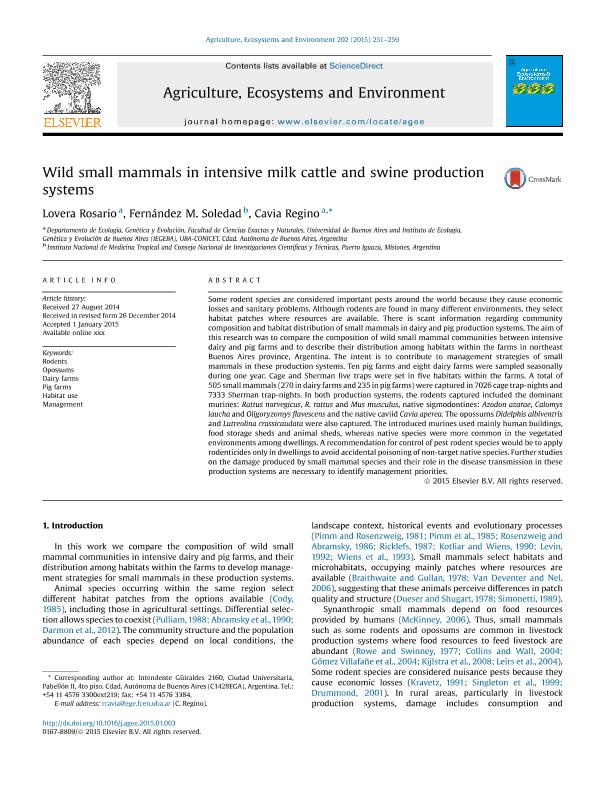Mostrar el registro sencillo del ítem
dc.contributor.author
Lovera, Rosario

dc.contributor.author
Fernández, María Soledad

dc.contributor.author
Cavia, Regino

dc.date.available
2017-12-05T18:14:43Z
dc.date.issued
2015-01
dc.identifier.citation
Lovera, Rosario; Fernández, María Soledad; Cavia, Regino; Wild small mammals in intensive milk cattle and swine production systems; Elsevier Science; Agriculture, Ecosystems and Environment; 202; 1-2015; 251-259
dc.identifier.issn
0167-8809
dc.identifier.uri
http://hdl.handle.net/11336/29761
dc.description.abstract
Some rodent species are considered important pests around the world because they cause economic losses and sanitary problems. Although rodents are found in many different environments, they select habitat patches where resources are available. There is scant information regarding community composition and habitat distribution of small mammals in dairy and pig production systems. The aim of this research was to compare the composition of wild small mammal communities between intensive dairy and pig farms and to describe their distribution among habitats within the farms in northeast Buenos Aires province, Argentina. The intent is to contribute to management strategies of small mammals in these production systems. Ten pig farms and eight dairy farms were sampled seasonally during one year. Cage and Sherman live traps were set in five habitats within the farms. A total of 505 small mammals (270 in dairy farms and 235 in pig farms) were captured in 7026 cage trap-nights and 7333 Sherman trap-nights. In both production systems, the rodents captured included the dominant murines: Rattus norvegicus, R. rattus and Mus musculus, native sigmodontines: Azodon azarae, Calomys laucha and Oligoryzomys flavescens and the native caviid Cavia aperea. The opossums Didelphis albiventris and Lutreolina crassicaudata were also captured. The introduced murines used mainly human buildings, food storage sheds and animal sheds, whereas native species were more common in the vegetated environments among dwellings. A recommendation for control of pest rodent species would be to apply rodenticides only in dwellings to avoid accidental poisoning of non-target native species. Further studies on the damage produced by small mammal species and their role in the disease transmission in these production systems are necessary to identify management priorities.
dc.format
application/pdf
dc.language.iso
eng
dc.publisher
Elsevier Science

dc.rights
info:eu-repo/semantics/openAccess
dc.rights.uri
https://creativecommons.org/licenses/by-nc-sa/2.5/ar/
dc.subject
Rodents
dc.subject
Opossums
dc.subject
Dairy Farms
dc.subject
Pig Farms
dc.subject
Habitat Use
dc.subject
Management
dc.subject.classification
Otras Ciencias Biológicas

dc.subject.classification
Ciencias Biológicas

dc.subject.classification
CIENCIAS NATURALES Y EXACTAS

dc.title
Wild small mammals in intensive milk cattle and swine production systems
dc.type
info:eu-repo/semantics/article
dc.type
info:ar-repo/semantics/artículo
dc.type
info:eu-repo/semantics/publishedVersion
dc.date.updated
2017-12-04T17:46:15Z
dc.journal.volume
202
dc.journal.pagination
251-259
dc.journal.pais
Países Bajos

dc.journal.ciudad
Amsterdam
dc.description.fil
Fil: Lovera, Rosario. Consejo Nacional de Investigaciones Científicas y Técnicas. Oficina de Coordinación Administrativa Ciudad Universitaria. Instituto de Ecología, Genética y Evolución de Buenos Aires. Universidad de Buenos Aires. Facultad de Ciencias Exactas y Naturales. Instituto de Ecología, Genética y Evolución de Buenos Aires; Argentina
dc.description.fil
Fil: Fernández, María Soledad. Universidad de Buenos Aires. Facultad de Ciencias Exactas y Naturales. Departamento de Ecología, Genética y Evolución; Argentina
dc.description.fil
Fil: Cavia, Regino. Ministerio de Salud. Instituto Nacional de Medicina Tropical; Argentina. Consejo Nacional de Investigaciones Científicas y Técnicas; Argentina
dc.journal.title
Agriculture, Ecosystems and Environment

dc.relation.alternativeid
info:eu-repo/semantics/altIdentifier/doi/http://dx.doi.org/10.1016/j.agee.2015.01.003
dc.relation.alternativeid
info:eu-repo/semantics/altIdentifier/url/https://www.sciencedirect.com/science/article/pii/S0167880915000043?via%3Dihub
Archivos asociados
